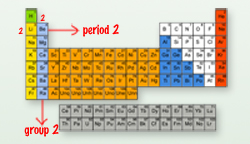The periodic table of elements can be divided into rows (across) and columns (down). The rows are called periods and the columns are called groups. They can tell you information about the elements.
Periods
Each row (going across) of the table is called a period. The top row of the table is the 1st period, the second row is the 2nd period, and so on.
The period that an element is in tells us how many electron shells it has. The number of the period is the same as the number of electron shells it has. For example, lithium (Li) is on the 2nd row of the table. That means it is period 2, so lithium has 2 electron shells.
Groups
Each column (going down) is called a group. The 1st column from the left is the 1st group, the 2nd column from the left is the 2nd group, and so on.
The group that an element is in tells us how many electrons are in its outer shell. For example, magnesium (Mg) is in the 2nd column from the left. That means it is in group 2, so it has 2 electron shells in total.

